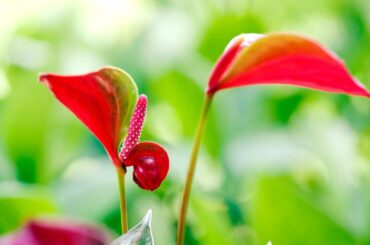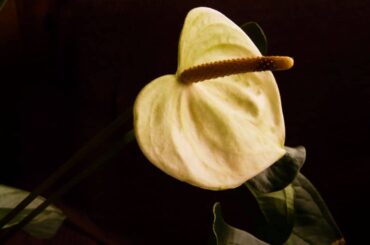Is propagating anthurium in water viable? I had the same question for some time. Then I found a perfect method to do it. So, if you’re looking for a simple method to expand your anthurium plant collection, this article is for you. Anthuriums are one of the most highly demanded houseplants with eye-catching foliage and blooms of durable flowers year-round.

Apart from their stunning beauty, anthuriums come with an excellent package of benefits, including but not limited to indoor air purification, Feng Shui effects, boosting mental health, and ease of airborne allergies. So, there is no doubt why anthuriums have gained such a huge attraction among plant lovers all over the world. Anthuriums are somewhat pricey plants. However, you can propagate them so easily at home.
Propagating anthurium in water: Can you ?
Well, you can propagate anthuriums hydroponically. Anthuriums can thrive well in water. Other than planting seeds, anthuriums are capable of propagating by division. Here, cuttings of the parent plant can be regrown into new individual plants.
Simply, just take a cut from your anthurium plant and place it in water. The speed of the regrowth of anthuriums depends on environmental factors, including temperature and light. New root growth happens faster in warm conditions and under plenty of bright light. Some gardeners may pot the plant in soil once it has developed a new root system.
Anyway, if you like, you can leave the new plant to grow in water. Anthuriums showcase their beauty well when they are grown in water in glass containers. Be mindful that, unlike growing in the soil, anthuriums may not gain enough nutrients consistently when they grow in water. Thus, if you wish to grow plants in water, it is so crucial to fertilize the plant to ensure healthy growth and development.
How to propagate anthurium in water? (step by step guidelines)
Beforehand, there are some important facts to keep in mind. Anthurium sap is poisonous as it contains calcium oxalate. If you touch the sap, it will irritate your skin. If ingested, you will feel a burning sensation and it will be really painful for you. So, before you begin propagation, take the necessary safety precautions to avoid anthurium toxicity.
Wear gloves and goggles. If you have children or pets, keep them out of the way while the work is being done. Propagation of anthuriums in water is not so tricky. For your convenience here, we have given the complete step-by-step process of propagating anthuriums in water.
Step 01: Select a healthy plant.
If you want to get a healthy-looking nice plant, you should avoid diseased plants because they might transfer the disease to newly growing plants as well. Therefore, selecting a healthy plant for propagation is important. It is ideal to select a plant that has outgrown the pot. You can select plants to split those roots growing out of the drainage hole and those the size is not compatible with the pot size.
Irrigate the plant a day before as it gets well moistened. This enables you to lose the soil, so you can easily expel them without damaging the plant’s root system.

Step 02: Make the materials ready.
During the process, you will need a cutting shear, a pruning shear, an old towel or paper sheet, and transparent containers filled with water. Collect all the materials that you want in advance. It would be better if you could disinfect the cutting shears prior to use to prevent any microbial infection. Make the station ready where you are going to propagate your anthurium plant.
Pay attention when selecting a container for the plant. Containers with narrow necks can interrupt taking the plants out of them. In addition, when propagating anthuriums in water, transparent containers are preferable as they help clear visualization of the root growth.
Step 03: Make the plant ready for the cutting.
Carefully take your anthurium plant out of the pot. Gently separate the roots with your fingers and remove the soil. To effectively expel soil, immerse the roots in tap water or, better, in rainwater.Check the plant for any offshoots to separate. Mark the anthurium plant to split.
Step 04: Make the cuts.
Cut the stem and trim all the leaves near the stem of the plant. Split the stem into several pieces as each piece carries at least two leaf buds. Use sharp, sterile pruning shears to make cuts. It is up to you to decide how far the stem should be split. It depends on the number of new plants you need.
Cut the stem fair over the roots. The root system and the stem part can be separately planted to get new anthurium plants. During the process, trimming off the leaves and flowers is essential. This helps preserve the energy that can be redirected to the newly emerging plants.
Step 05: Place the cuts in the water.
Place the anthurium cuts in the upright position in transparent containers that are filled with water. Completely immerse the bottoms of the cuts in water. However, you should not submerge the leaves in water as it can cause rotting. Use clean tap water or rainwater. Do not use water with a high chemical load or distilled water as it can interfere with the growth of the plant.
Step 06: Spot the container in the proper place.
Keep your containers in a warm, moist, and bright spot. Avoid dark, extremely cold or hot places to keep your anthurium containers. Most importantly, locate your plant in an environment that the anthuriums crave. It will take a few weeks to see the growing of new roots in the water. Once the new plants have grown large enough, you can transplant them into new pots.

How to take care of anthurium in water?
Regardless of the growing medium, anthuriums that grow in water have the same basic requirements as those that grow in soil. Regulating the ambient environment in terms of light, temperature, humidity, and water quality is crucial to developing a healthy plant. Remember that the key to achieving a high success rate is to create an environment for the plants they prefer.
Light
To favor healthy growth, newly propagated anthurium plants should be exposed to indirect bright light. You can provide indirect sunlight or artificial light (LED light) for newly developing plants. While using LEDs as a lighting source, the plants should be exposed to the light for a longer period of time than when growing in indirect sunlight. However, you do not keep the plants in the harsh sun unless you want to kill them.
Temperature
The perfect temperature for optimal plant growth ranges from 15 to20 degrees Celsius. Anthuriums are tropical plants, so they prefer warmth. Keep anthuriums away from heater vents and stoves. The plants can be stressed if they are exposed to high temperatures.
Humidity
Anthuriums seek high humidity levels. Unlike when they grow on solid substrates, when they grow in water they gain enough dampness around them. Therefore, regular maintenance of high humidity around the plant might be unnecessary. Nevertheless, once you’ve decided to grow anthuriums in water, there are some important things to take into account.
Nutrient and water level
You should be more attentive to providing enough nutrients and maintaining water quality when anthuriums are propagated in water. Since plants are grown in water, it doesn’t mean that you should not care for the water requirements of the plant. Yes, obviously you do not have to water the plant as frequently as you do for other anthuriums grown in soil.
You have to top up the water level in the glass container. Use mineral water or rainwater for this purpose. They contain some essential mineral nutrients that help plant growth. In fact, water should be replaced once a month to keep algae away from your plants.
If algae invade water, they will compete for nutrients and energy with newly developing anthuriums. If this happens, propagated plants will be discouraged from growing. Naturally, nutritional components are constantly accumulating in the soil. Thus, plants that root in the soil can readily absorb these nutrients and use them for their own growth and development.
However, this is not the same scenario as growing a plant in water. Water as a growth medium carries a limited number of nutrients, and there is no such room for continuous accumulation of nutrients in the water. Once the available nutrients are depleted, they must be replenished by fertilization. Your new anthurium babies are struggling to grow. So, do not forget to feed them a nutritious diet.
Whereas you replace the water in the container, add some drops of anthurium fertilizer to the water. Liquid-type fast-release fertilizers for anthuriums are much better in this regard. They can quickly correct the nutrient levels in the water between each water replacement.
Conclusion
Summing up, it is easy to multiply your anthuriums in water. Here, you can use stem cuttings and root cuttings to obtain new plants. This enables you not only to increase your anthurium population but also to solve rootbound problems as well.
Always use a transparent container if you want to propagate anthuriums in water. This allows you to observe the changes happening inside it. Create the proper environment for your newly developing anthuriums. To have happy growing anthuriums, keep the water quality in mind.
Read Next : Watering Anthurium With Ice Cubes (Correctly)





